When purchasing an apartment with a mortgage, the deposit is transferred from the buyer to the seller and provides the latter with confidence that the transaction will take place. What are the features of this payment and the rules for its execution? How is money transferred? What does the legislation say? Our article will give you answers to these and other questions.
From this article you will learn:
- Why do you need a deposit when buying an apartment with a mortgage?
- How does a deposit differ from an advance and a deposit?
- How to properly fill out a deposit when buying an apartment with a mortgage
- In what cases is the deposit returned to the seller of the apartment?
What is a deposit when buying an apartment with a mortgage?
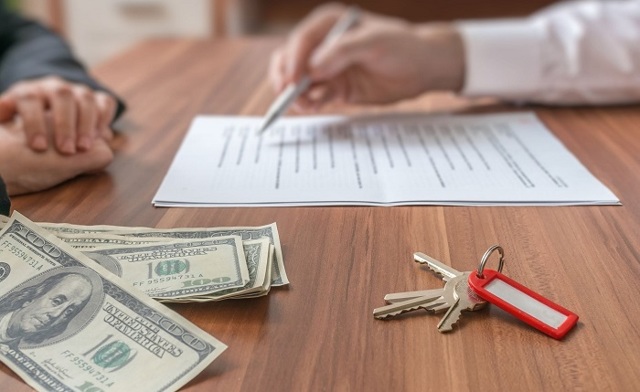
When purchasing an apartment with a mortgage, the buyer often transfers an advance or deposit to the seller, thereby confirming the seriousness of his intentions. According to Art. 380 of the Civil Code of the Russian Federation, we are talking about the amount of funds that the owner of the property receives to pay for it.
Payment is made according to a preliminary agreement, which is drawn up in writing.
The main feature of the deposit is that in case of violation of obligations, it will not be returned to the buyer, while the advance payment will be transferred back without any consequences.
Article 454 of the Civil Code of the Russian Federation regulates the procedure for transferring the subject of the transaction, and Article 381 - the consequences that may occur as a result of violation of the requirements of the preliminary agreement. The procedure for transferring money when purchasing real estate with a mortgage is regulated by a number of legislative acts.
In this case, it is mandatory to comply with a number of rules:
- The agreement should indicate the amount of funds transferred to the seller, as well as the date and terms of payment for the entire cost of the apartment. In addition, the date of conclusion of the basic contract should be indicated here.
- It is important that all owners of the property being sold take part in the registration process, if there are two or more of them.
- The seller of the property must confirm ownership of it.
What functions does a preliminary agreement on a deposit perform when purchasing an apartment with a mortgage?
- Evidence-based . This agreement serves as confirmation that the contract for the sale of housing between the seller and the buyer has been concluded.
- Payment _ The deposit amount is counted towards the cost of the purchased apartment.
- Security . The agreement ensures the obligations of the parties when completing a transaction.
According to the law, an advance payment when purchasing an apartment with a mortgage can be transferred from the buyer to the seller without the presence of third parties. At the same time, experts recommend inviting a lawyer, a notary office employee or a real estate agency specialist who can act as witnesses in the event of controversial situations.
What is the difference between an advance and a deposit from a deposit when buying an apartment with a mortgage?
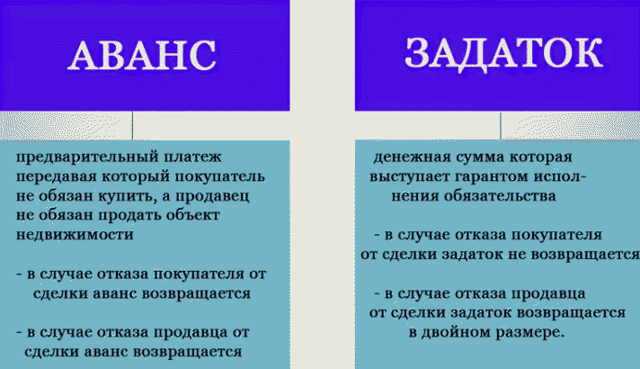
Many of us often confuse the concepts of advance, deposit and deposit, throwing them “into one pile” and equating them to each other. However, experts argue that there are significant differences between these methods of ensuring the fulfillment of obligations.
Today, the word “collateral” is often used for other purposes. If the buyer says: “I paid a deposit for the apartment,” then in fact he may mean both a deposit and an advance. Most likely, we are talking about concluding an agreement between individuals or investing funds in a company.
At the same time, the economic dictionary states that a pledge is one of the ways a debtor fulfills his obligations when he pledges real estate or other valuables to the creditor (pledgee). And now it becomes clear that the use of this term in the above example was inappropriate.
The concept of “advance” is well known to each of us. In terms of real estate transactions, it means that the buyer transfers a certain amount of funds, which is only part of the cost of housing, towards the purchase of an apartment.
As for the seller, he may well dispose of the money received at his own discretion, but if the transaction is cancelled, he will have to return it.
The buyer makes an advance payment, as if confirming his word of honor, but no official obligations on either side are recorded.
As you can see, the scheme is quite understandable and fair, however, as practice shows, it is not always implemented. To avoid problems in the future, it is important to conclude a purchase and sale agreement in writing with a mandatory indication of what exactly the buyer paid - a deposit or an advance payment. Strict adherence to all formalities disciplines all participants in the transaction.
How to draw up a deposit agreement when buying an apartment with a mortgage

When drawing up a deposit agreement, it is important to take into account that the apartment is purchased on the terms of a mortgage. This clarification is fundamentally important for the buyer, because the bank considers the deposit as part of the down payment, and therefore, in case of refusal, the person can return his money on the basis of clause 1 of Art. 381 of the Civil Code of the Russian Federation.
This clause states that, in the event of termination of the obligation due to the impossibility of its fulfillment, the deposit amount is subject to return. At the same time, there is no clear definition that this wording also applies to the refusal of a loan.
Therefore, the deposit agreement must indicate a negative credit decision of the bank as one of the conditions for return.
Before signing the agreement, check the following information in its text:
- Information about the participants in the transaction . The contract must contain information about the buyer and all owners of the property: their full names, series and numbers of passports, places of actual residence or registration.
- Information about the apartment : its address, total and living area, cadastral number, cost. If you wish, you can provide additional information - for example, the number of the extract indicating ownership of the property.
- Conclusion date . This will allow you to prove in any controversial situation exactly when the contract was concluded.
- Deposit amount . It is indicated in numbers and must be deciphered in words.
- Procedure for transferring funds . It should be indicated when the buyer transfers money to the seller and in what way. For example, you can write that the entire amount was transferred in cash when signing the agreement, or indicate the details of the current account.
- Time of completion of the apartment purchase and sale transaction . Indicate the time frame allotted for the execution of the main purchase and sale agreement. Try not to use abstract phrases (for example, “within a month”), but specific dates (say, until 10/31/2018).
- Rights and obligations of the parties to the transaction . The primary obligation of the seller is to hand over the apartment in the condition in which it was upon inspection, and the buyer is to make timely payment.
- Force majeure circumstances . It is necessary to identify which situations should be considered emergencies, and also describe their impact on the terms of the agreement.
- Effective date . Most contracts come into force at the moment of their signing.
- Signatures of the parties . In the final part of the agreement, each participant in the transaction puts his signature and deciphers it, indicating his last name with initials.
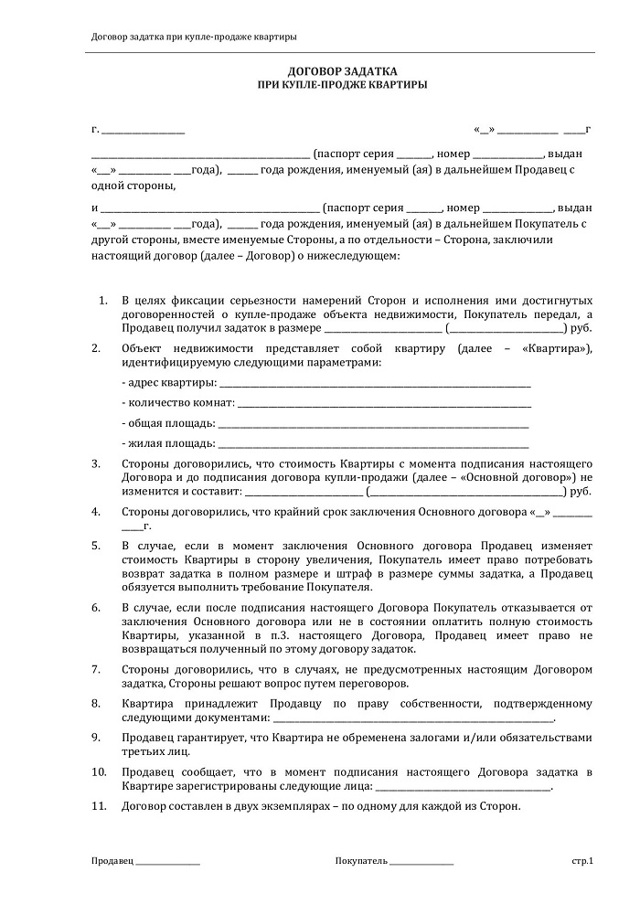
If necessary, the agreement can be supplemented with a clause indicating any details that are significant for the participants. The agreement, which is not subject to mandatory notarization, is drawn up in two copies.
Sample agreement on deposit when purchasing an apartment with a mortgage
Take advantage of the recommendations of experienced realtors and supplement the agreement with a certificate from a psychiatrist confirming that the participants in the apartment purchase and sale transaction are of sound mind and memory. In the event of unfavorable developments, this document will save you from litigation on this issue.
Important! Having received the deposit, the seller personally indicates on both copies its exact amount (not only in numbers, but also in words), full name, current date and signature.
After discussing the main terms of the transaction, the parties sign an agreement taking into account the agreements reached. Having transferred the deposit when purchasing an apartment for a mortgage in the agreed amount, the buyer must take a receipt from the seller stating that he has received the funds.
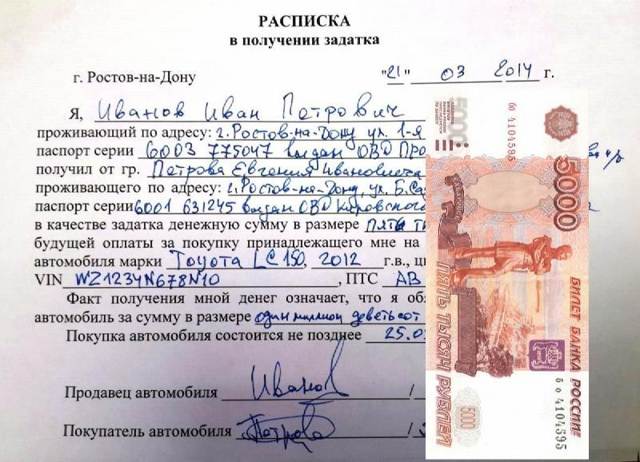
An additional measure to protect the interests of the buyer is for the seller to write a receipt manually with a ballpoint pen. The fact is that it is much more difficult to fake a person’s handwriting than his signature. A printed copy of the receipt for receipt of the deposit must be notarized.
When conducting a transaction to purchase a home with a mortgage, you must provide copies of the agreement and receipt to the bank. The transfer of funds can be carried out non-cash, in which case a payment order will be required from the bank.
Amount of deposit when purchasing an apartment with a mortgage

You've probably wondered what amount (percentage of the total cost of the apartment) should be provided as a deposit. These funds are usually transferred for a certain period of time, after which the parties enter into the main contract for the purchase and sale of real estate.
The amount of the deposit is not regulated by regulations, so you will not be able to find information on this issue in primary sources (for example, in the Civil Code). It is a generally accepted practice to determine this amount by participants in an apartment purchase and sale transaction.
Typically, in such transactions, the amount of the deposit ranges from 5% to 10% of the market value of the property.
Attempts by one of the parties to significantly increase or decrease the amount of the deposit should seriously alert the second party to the apartment purchase and sale transaction.
If the seller insists on increasing this amount, then it is quite possible that he expects to receive a more advantageous offer from third parties, or the cost of housing is greatly inflated.
The buyer's attempts to reduce the deposit may indicate that his choice is not final, and the process of searching for real estate continues.
In what cases is it possible to return the deposit when purchasing an apartment with a mortgage?

Article 381 of the Civil Code of the Russian Federation states that the deposit is returned to the buyer if the seller fails to fulfill his obligations. In particular, if he:
- did not register all the residents registered in the apartment. People registered in the residential area have the right to live on it, so the property is considered to be under an encumbrance.
- changed the decision to sell the home regardless of why he did it;
- did not pay off debts on utility bills before the sale and purchase transaction, which is contrary to current legislation;
- provided deliberately false information when concluding a preliminary agreement on a deposit when purchasing an apartment with a mortgage (for example, the seller could hide the fact that the apartment has several owners);
- did not comply with the terms of the preliminary agreement (for example, did not prepare documents for sale);
- did not appear to sign the main agreement for the transaction on the specified day.
In all of the above situations, the seller must not only return the deposit to the buyer in full, but also pay him the same amount on top as a fine.
Study in advance the information on how to get your money back if the seller violates the terms of the contract. Usually, it is enough for the buyer to inform the other party about the need for a refund. If the seller refuses, you should file a lawsuit - most likely, it will be satisfied.
Drawing up a deposit agreement when purchasing an apartment between individuals

Today we will talk about how to correctly fill out a deposit when buying an apartment, whether it is possible to return the deposit and how to write a receipt for receipt of funds. Also here you can download samples of the indicated documents and consult with our on-duty lawyer online for free.
The deposit when purchasing an apartment is a certain amount in monetary terms, which the buyer transfers to the seller towards the cost of the property, as evidence of the intention to conclude a transaction and ensure all the conditions of this transaction.
Thus, the deposit acts as a kind of guarantor that the purchase and sale of a certain apartment will be completed by the parties according to a certain agreement. The deposit guarantees to the buyer that the apartment will not be sold, and it will wait for him for a specific amount of time, and at a fixed price.
For the seller, the deposit indicates the firmness of the buyer’s decision to purchase his apartment, as a result of which he is no longer looking for other buyers. The deposit encourages the parties to the transaction to fulfill their obligations.
The deposit is an advance payment for the apartment, and is taken into account in the cost of the apartment after the transaction is completed.
But in our world you should not rely on a good name and word of honor, because an apartment is not a bag or even a middle-class car, it is a piece of real estate where, “if something happens,” you can lose huge amounts of money. Therefore, the prepayment for the apartment given to the seller must be formalized legally correctly.
The amount of the deposit is not determined by law; it is agreed between the parties independently . Most often, a percentage of the total cost of the apartment is taken in the range of 5-10. But everything depends on the agreement.
The transfer of the deposit guarantees that the buyer will purchase exactly the apartment for which he paid. This operation must be legally formalized, i.e. draw up a deposit agreement.
And here you shouldn’t simplify the procedure and get away with just the seller writing a receipt stating that he received money for the apartment.
Such a receipt, not supported by any other document, does not guarantee the return of the deposit in case of unforeseen situations , and it is a rather problematic document to challenge in court. A receipt, of course, is needed, but only as confirmation of receipt of funds under the deposit agreement.
Important points when drawing up a deposit agreement
Before you give the seller an advance payment for the apartment, you must draw up a deposit agreement. How to apply? Its form is not established by law, but standard samples can be downloaded below, or asked from the real estate agency that processes this transaction. In any case, when concluding a contract, it is necessary to take into account the following mandatory points:
- Parties to the transaction: full name, passport details, addresses. The owner of the apartment is indicated as the seller, and if there are several of them, then it is best to indicate all of them.
- All essential information about the apartment. Address, square meters, other characteristics. Be sure to indicate the full total cost of the apartment.
- The amount of the deposit is indicated in the contract both in numbers and in words. The timing of the transfer of the deposit and the method of its transfer are agreed upon. The deposit can be transferred either in cash or through bank accounts. In the first case, a receipt is required, in the second, confirmation is a bank statement. When transferring through a bank, the contract must indicate the specific accounts of the apartment owners.
- Obligations of the parties. For the seller, this is an obligation to vacate the apartment from both residents and registered persons and other similar actions related to preparing the apartment for sale. For the buyer - payment obligations.
- Responsibility of the parties. Each party is assigned responsibility for the failure of the transaction. The buyer, for any reason, may refuse the property, which threatens him with the loss of the deposit. If the owner refuses the purchase or sale of an apartment, then he undertakes to return 2 deposits to the buyer .
- Other essential conditions. This could be, for example, a clause about the division of utility bills, or about leaving furniture, etc.
- Timing of the deal. A mandatory clause of the deposit agreement is strictly defined terms for concluding the final purchase and sale agreement and registration of the transaction with the authorized government agency.
We can say that the deposit “binds” the buyer and seller. Of course, there are also force majeure circumstances when the deposit can be returned, which must be specified in the contract.
The deposit agreement is written in 2 copies, one for the buyer, and the other for the seller, or one of the sellers, if there are several of them.
Correct drafting of this agreement is the key to success. It does not require it to be certified by a notary (although this is desirable), but it is best if the agreement is drawn up by a lawyer. This will protect the buyer from pitfalls.
Correct execution of the receipt when transferring the deposit
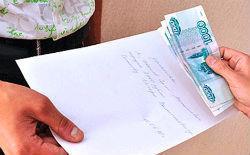
The receipt is written by the seller himself, using a ballpoint pen when writing. In case of problems, a handwriting examination will put everything in its place. Whereas it is more possible to forge a short signature. If the receipt is printed using a computer, then this option should be certified by a notary .
A receipt is written at the time of transfer of funds. It is best if there are witnesses from the buyer’s side - not relatives and friends, but strangers.
When writing, the seller must indicate:
- The name of the document is “Receipt”, and also indicate which deposit agreement it relates to (No., number).
- Date of preparation.
- Parties, their full passport details.
- Call the sum of money he receives a deposit (and nothing else).
- The deposit amount is indicated in numbers and words.
- Description of the property. It is also advisable to include in the receipt brief characteristics of the property that were specified in the deposit agreement.
- Seller's signature. It is desirable that it be the same as in the passport.
Important point : if the apartment is owned by several persons, each of them must draw up a receipt in order to avoid further claims against each other.
The owners write identical receipts, where only the amount of the deposit changes, which is divided into each person in proportion to the shares indicated in the document on ownership of the apartment.
If the owners have minors, then a parent or guardian acts on their behalf.
If the deposit given to the seller when purchasing an apartment is not properly processed, this will undermine the financial security of the buyer. And the best option would be to draw up both a deposit agreement and a receipt from a notary.
If you cannot figure out on your own how to draw up a deposit agreement when purchasing an apartment, or you need help in drawing up legally competent documents for the purchase and sale of real estate, then our duty lawyer is at your service.
How to prepare a deposit when buying an apartment with a mortgage
 A deposit when buying an apartment with a mortgage is a specific amount that is transferred from the buyer to the seller and guarantees a purchase and sale transaction in the future. What are the features of such a payment? How is it formatted correctly? Do I need to leave money when purchasing? What does the legislation say? These and other questions require consideration.
A deposit when buying an apartment with a mortgage is a specific amount that is transferred from the buyer to the seller and guarantees a purchase and sale transaction in the future. What are the features of such a payment? How is it formatted correctly? Do I need to leave money when purchasing? What does the legislation say? These and other questions require consideration.
Legislation
When buying an apartment with a mortgage, the person who receives the property often leaves the buyer an advance or a deposit.
The Civil Code of the Russian Federation (Article 380) states that the deposit is an amount that is transferred from the buyer to the seller as payment for the goods and acts as evidence of the seriousness of intentions. The preliminary agreement for making a payment is drawn up in writing.
The main difference is that if obligations are violated, the funds are not returned, but the advance payment goes back to the buyer without any consequences.
In addition, Article 454 of the Civil Code of the Russian Federation describes the procedure for transferring the subject of the transaction, and Article 381 discusses the consequences that a violation of the requirements of the preliminary agreement entails. There are also a number of legislative acts regulating the process of transferring money when purchasing real estate into a mortgage.
Main rules
The stages of transferring a deposit (advance payment) include drawing up an agreement between the parties (drawn up in writing), as well as filling out a receipt that confirms the fact of transfer of cash when purchasing a home. Main rules:
- The agreement specifies the amount of funds that are given to the seller, as well as the conditions and day of payment of all funds. The date for concluding the basic agreement is also specified here.
- The person who sells the property confirms ownership of it.
- All owners of the property being sold (if there are 2 or more of them) participate in the registration process.
The law allows the transfer of money when buying an apartment with the participation of two parties. But it is better if a third party is present - for example, an employee of a notary office, a lawyer or a representative of a real estate agency. When controversial issues arise, the mentioned persons act as witnesses.
Subtleties of drawing up a contract
Documentation that confirms the fact of issuing a deposit (advance payment) must be drawn up correctly, indicating the conditions, information about the participants and subject to compliance with legal requirements.
It is worth considering that the nuances of paperwork in each agency or bank may differ, so it is important to obtain the information of interest directly in the office or on the organization’s website.
As a rule, the mentioned structures post a sample receipt and agreement implying the transfer of an advance payment when purchasing a home.
If we are talking about purchasing an apartment or house with a mortgage, you must notify the banking institution of your desire to transfer the deposit. The latter subtracts the specified amount from the down payment amount. Funds can be transferred in cash or transferred to an account (card).
Drawing up documents when purchasing real estate with a mortgage is no different from a classic transaction:
- The agreement is drawn up in two versions - for one and the other party.
- A copy of the above-mentioned paper is made and sent to the creditor bank.
- The buyer issues finance in the agreed amount.
- The recipient of the funds (seller) draws up a receipt.
- A copy of the receipt is provided to the creditor bank.
The agreement is drawn up in accordance with the law, if the owners of the property are specified in it, the parties to the transaction are indicated, information about the cost of housing and the amount of the deposit (advance) is mentioned. In addition, the document must contain information about the real estate itself and liability for failure to comply with conditions.
To give or not?
When buying an apartment with a mortgage or directly, many doubt whether they need to give money as a guarantee of the transaction. This is not necessary, but to protect personal interests and to avoid wasting time, the seller often requires payment of a certain amount. The latter confirms that the buyer will not abandon his intention to purchase the property.
Subtleties of transferring funds and drawing up an agreement
When drawing up a preliminary agreement during the purchase process, it is important to specify the definition (nature) of the amount transferred. If the document does not stipulate that the money is a deposit, the court will consider the payment an advance.
As a result, if the buyer refuses to purchase, the seller will be obliged to return the money, because they do not have the function of securing a transaction between the parties. Obligations of participants during purchase and sale (under the terms of Art.
359 of the Civil Code of the Russian Federation) are secured by a guarantee of third parties, a pledge or a bank guarantee.
Payment amount
The size of the deposit is not specified by law, and the issue is resolved through agreement between the parties to the transaction.
Today there are two ways to determine size:
- As a percentage of the property price. As a rule, the advance amount is up to 5%, but there are situations when payments reach 10-12% of the housing price.
- In a fixed form. In this case, the size of the payment does not depend on any factors. As a rule, this amount ranges from 50 to 100 thousand rubles (by agreement of the parties). The size can change up or down (the law does not prohibit this).
In this case, the amount of the deposit (advance payment) must be indicated in the agreement between the parties.
How to issue a receipt?
When purchasing an apartment with a mortgage or directly (if a decision is made to transfer the contribution), the seller must write a receipt confirming receipt of the money. The document is drawn up on white paper and without a specific form. The main thing is that it reflects the following points:
- Document's name.
- Personal information of participants.
- The cost of purchasing real estate (determined taking into account the cadastral or market price).
- Day of transfer, scope, goals and reasons.
- Date of execution of the basic contract.
- Brief description of the object (address, numbers of documentation that establishes rights to real estate).
- Conditions for refund (in case of delays in the execution of the basic contract).
- The nuances of counting the transferred amount into the total cost of the apartment (including when applying for a mortgage).
Both parties sign the receipt (after checking the information specified in the document). The best option is if two people are present during the transaction, who, if necessary, will confirm the fact of the transfer of funds. The money is given immediately after receipt of the receipt. It is the responsibility of the recipient to ensure that the agreed amount has been transferred to him. The recount is carried out in the presence of witnesses.
What documents will be required?
When transferring a deposit (advance payment), you will need a number of other papers, including personal documents (buyer and seller), passports (cadastral and technical), a certificate of encumbrance (when registering a mortgage), an extract from the Unified State Register of Real Estate, as well as a title deed.
What does the seller risk?
During the sale process, the owner of the apartment bears the greatest risks. But each situation is individual and there are no uniform recommendations for protecting interests. To avoid problems, it is important to ensure that the contract is drawn up and a number of information are indicated in it (listed above). In addition, the seller must be sure that the buyer has funds to complete the transaction.
It is worth considering the following points:
- The method and date of transfer of money when purchasing an apartment with a mortgage or cash.
- Subtleties of mutual settlements (specified in the contract).
- Option for transferring money (the best option is using a safe deposit box).
It is worthwhile to carefully study the buyer, because the latter may assure that he is ready to make a transaction, but in fact he does not intend to make a purchase due to various circumstances. Depositing a certain amount and drawing up a preliminary agreement allows you to avoid risks and ensure the seriousness of the second participant.
How to return the deposit if a credit institution refuses a mortgage?
There may be situations when, when applying for a mortgage, the bank refuses to issue funds. Here the question arises of how to return the money previously transferred. To avoid difficulties, it is important to carefully approach the preparation of the preliminary agreement.
It is important to indicate in it the amount that is paid for the purchase of real estate, as well as the amount of funds that the banking institution issues within the mortgage. It is necessary that the document describes the guarantees, as well as the consequences for failure to fulfill obligations.
It is important to indicate that the deposit is returned to the buyer if the credit institution refuses to formalize the agreement.
How to apply for a refund?
Situations end well when the parties fulfill their obligations. But this doesn't always happen. Several situations can be distinguished here:
- The buyer changed his mind and demands a return of the previously transferred funds. The seller has the right to expect compensation for costs (in full or in part, depending on the terms of the agreement).
- The owner of the apartment kept silent about the problems with the property and delayed the sale. In this case, the buyer has the right to demand a double refund.
- The buyer received a refusal from the bank, and the other party does not want to give the funds. The consideration of the case is transferred to the judicial authority, which in most cases is on the buyer’s side.
Subtleties of drawing up an agreement for a mortgage at Sberbank
The principle of buying an apartment in Sberbank with a mortgage has a number of differences. In particular, after receiving approval, the credit institution allocates 120 days to find suitable housing and resolve legal issues.
During this period, it is necessary to prepare papers and draw up an agreement. At the same time, Sberbank does not put forward strict requirements for the house, but sets them for the living space. The latter must be legalized.
In addition, execution of a preliminary purchase and sale agreement is mandatory. It should contain a description of the size of the deposit (advance) and the specifics of their return.
In addition, the buyer transfers the advance payment to the account of a banking institution, which is an additional guarantee for the seller.
How to draw up an advance agreement - sample
In order to correctly draw up a document on the transfer of an advance payment when purchasing real estate (on a mortgage or directly), it is advisable to have a sample agreement before your eyes. The contract states:
- Place and time of registration (at the top), that is, the name of the locality and the day of conclusion.
- Information of the parties - full names, addresses, information from the passport and telephone numbers.
- Information about the apartment - the object of the transaction, the price of housing and the date of execution of the basic contract.
- The amount of the deposit or advance (in numbers and text).
- Features of money transfer.
- Rights and obligations of participants (when filling out, the Civil Code of the Russian Federation, Article 381 is taken as a basis).
- Indication of the validity of the contract from the date of signing.
- Force majeure and its effect on the document.
- Details of the buyer and seller, as well as their signatures.
Mortgage without advance
There are situations when a person buys an apartment and does not want to draw up an agreement for the transfer of an advance payment or deposit. This situation is possible. Moreover, many banks allow you to apply for a mortgage without making a down payment, but in such cases the interest rate increases. Persons who have Russian citizenship and can confirm their income have the right to count on the service.
Results
Above, we looked at whether a deposit is needed when buying an apartment, what functions it performs, and how to formalize the transfer of money taking into account the law. Practice shows that when buying an apartment, an advance payment of part of the cost of the apartment protects the interests of the seller and provides guarantees to the buyer, so it is not recommended to ignore such an instrument.
Loading…
Deposit, deposit when buying an apartment
Home / Purchase and sale of apartments / Resale and new housing / Deposit, deposit when purchasing an apartment
Views 13

The terms “deposit” and “pledge” have different meanings. When planning to buy an apartment, you need not only to choose the right measure that will ensure accurate fulfillment of obligations, but also to correctly prepare the necessary documents.
What is the difference between a pledge and an earnest money deposit?
DepositDeposit| Legislative norms | Art. 334 Civil Code of the Russian Federation | Art. 380-381 Civil Code of the Russian Federation |
| Form | Property (car, apartment, land, etc.) | Money amount |
| Functions | Used as security for fulfillment of obligations, but is not considered an advance payment under the contract | Ensures the fulfillment of obligations, and also becomes an advance payment under the contract |
When selling a property, a deposit is used - this measure guarantees compliance with obligations.
By transferring money to the other party, the buyer confirms his desire to enter into an agreement with this particular seller and actually makes a down payment (this amount is deducted from the total cost of the apartment, the balance is stated in the agreement).
The seller, by accepting money, guarantees that the property will be sold to the buyer. The agreement is not concluded verbally - a document must be drawn up (the amount does not matter).
Violation of accepted obligations by either party results in penalties.
Collateral is not used when registering purchase and sale transactions.
It is also a way to ensure the fulfillment of obligations, but in a different area - a bank can issue a loan against the security of an apartment so that the buyer can pay the seller.
If the person who took the loan violates its obligations (does not repay the debt), the collateral is sold at public auction and the bank receives the required funds (Article 350 of the Civil Code of the Russian Federation).
What happens to the deposit when the transaction is cancelled?
The deposit is a guarantee of the seriousness of intentions - it will not be possible to refuse obligations without consequences. Many sellers prefer to protect themselves from financial losses, so they prefer an advance payment - if a more profitable buyer is found, they can simply return the money without any sanctions.
In the case of a deposit, the amount received will have to be given to the buyer in double amount (i.e., having received 50 thousand, you need to return 100 thousand). Buyers can count on double compensation if the seller:
- refused to sell his property, despite a preliminary agreement;
- did not register the residents registered in the living space;
- has debts on utility bills and did not pay them off before selling;
- omitted important information (for example, that there is still an owner or that minor residents are registered);
- violated the agreed terms;
- ignored the signing deadlines.
In all these cases, the seller is obliged to pay the buyer. If he refuses to do this voluntarily, then the court will oblige him (the buyer will have to file a lawsuit in court).
A buyer who, for some reason, cannot fulfill what he promised, also loses money - the entire amount paid remains with the seller as compensation (clause 2 of Article 381 of the Civil Code of the Russian Federation).
In accordance with Art. 416 of the Civil Code of the Russian Federation, an obligation may be terminated if, for reasons beyond the control of the parties, it is impossible to fulfill it.
Read more: What is the difference between an advance and a deposit when buying an apartment
Is a deposit required when purchasing an apartment?
Making a deposit is not a mandatory procedure - the money is transferred to the seller as agreed by the parties.
Despite the fact that a deposit is not a mandatory payment, you should not refuse this method of controlling the situation. Donating money is motivating.
The parties take a more responsible approach to meeting deadlines at all stages - from the preparation of documents and the conclusion of the main agreement, to the transfer of real estate.
The risk of the seller increasing the price of the property disappears, and the buyer does not have the desire to demand a reduction in price.
Deposit size
The amount can be any - the issue is resolved through negotiations between the parties. As a rule, the amount of payments is tied to the cost of the object and amounts to 5-10% of it. If an apartment costs 2 million rubles, then you can put 100-200 thousand as a deposit.
Since neither party to the transaction is insured against force majeure, it is advisable to agree on a reasonable amount of the deposit. The amount should be sufficient for motivation, but not too large.
If for some reason the transaction has to be cancelled, the losses will not be critical. This is especially true for sellers who, in case of violation of obligations, will be forced to pay double the amount.
Rules for registering a deposit when purchasing an apartment
Before transferring money, you should:
- carefully study the real estate documents;
- make sure that the seller’s spouse does not object to the transaction, that there are no encumbrances (restrictions on rights are imposed by mortgage, arrest, rent, lease, trust management);
- check the apartment for utility debts and registered tenants (debts must be paid and tenants must be registered). We recommend reading: How to independently check an apartment for purity of the transaction before purchasing
Only legally capable persons can take part in a purchase and sale transaction. Experienced realtors recommend that both parties take care of obtaining a certificate from a psychiatrist, which will confirm the ability to be responsible for their actions. Considering the extensive judicial practice related to challenging transactions due to the incapacity of the participants, such a measure would not be superfluous.
Having made sure that everything is in order, you can proceed to the next stage - negotiations between the parties. In addition to buyers/sellers, lawyers/realtors can participate in them. If a minor is involved in a transaction, then his interests are represented by adults (parents, guardians, trustees).
Negotiations should discuss:
- the amount of the payment made – from 5% of the transaction amount;
- how it will be transferred to the other party - cash/non-cash;
- what responsibility will the parties bear?;
- circumstances that will cancel liability - if they occur, the buyer may be returned the deposit, and the seller will be allowed to return the amount without doubling it;
- additional nuances - for example, registering all residents before the transaction is completed.
After discussing the details of the transaction, it is time to draw up/sign papers. To prevent the deposit from being perceived as an advance, a preliminary purchase and sale agreement must be drawn up along with the agreement on its transfer.
If only one document is drawn up, then the court will recognize the amount of money as an advance, and such payment actually does not obligate anyone to anything (does not perform a security function). A receipt for receipt of money will also be required.
Documents can be drawn up independently; the participation of a notary is not required. If you have any doubts about the correctness of the wording, you can seek help from a lawyer - he will explain the complex points.
Development of the text of the preliminary purchase and sale agreement
This document is an obligation to conclude the main agreement in the future (clause 1 of Article 429 of the Civil Code of the Russian Federation). It contains the same information:
- data of the parties (if a child under 14 years of age is involved in the transaction, a birth certificate is required, as well as a passport of one of the parents, we recommend reading: Risks when buying an apartment with minor children);
- deadlines for concluding the main contract (if the date is postponed for any reason, then an additional written agreement is required - it is attached to the preliminary contract);
- housing costs;
- the amount transferred to the seller in words/figures indicating that this is a deposit;
- method of settlements with the seller;
- all characteristics of the property (area, address, floor, etc.);
- data of the title document (exchange agreement, donation agreement, privatization agreement, purchase and sale agreement);
- liability of the buyer and seller in accordance with Articles 380, 381 of the Civil Code of the Russian Federation;
- force majeure circumstances discussed at the negotiation stage, additional nuances.
The number of copies must correspond to the number of participants in the transaction. Additional copies may be required by the guardianship authorities (if the participant in the transaction is a minor), a bank or other organizations.
Documents are signed by buyers and sellers. A parent (guardian) signs for a minor child. A 14-year-old teenager must sign himself, and one of the parents (guardian, trustee) signs next to him.
Drawing up a deposit agreement
This document is an annex to the preliminary agreement and is drawn up for the purpose of proper fulfillment of obligations. It provides the following information:
- date of signing;
- buyer/seller data;
- the amount of the deposit indicating that it goes towards paying for housing;
- what responsibility the parties bear (in the case of the seller, the period within which the deposit must be returned in double amount is indicated).
The paper is signed by the parties. The number of copies is calculated in the same way as in the case of a preliminary agreement.
How to make a deposit correctly?
Money should be transferred only after completing/signing a receipt. Both non-cash and cash payments are accepted. In the first case, you need to indicate the purpose of the payment (deposit under the contract), and in the second, wait until the seller, having counted the money, confirms the absence of claims.
Regardless of the payment method, the receipt is written manually with a ballpoint pen (gel pen cannot be used, like a pencil). Handwritten text makes it possible to identify a person - it is extremely difficult to fake handwriting, which cannot be said about a signature. The following registration requirements are mandatory:
- the document must have a title ( receipt of receipt of the deposit under the contract - the date of conclusion of the latter is indicated);
- date when the receipt was written;
- information about the seller/buyer;
- amount in numbers/words;
- brief information about real estate;
- signature.
All data included in the receipt should be carefully checked to exclude the presence of intentional or accidental errors in the text. Particular attention should be paid to the amount and passport data, as well as the date.
Deposit when buying an apartment with a mortgage
Purchasing an apartment with a mortgage has its own characteristics, but a deposit can also be used when completing the transaction.
If during the negotiations the need for this method of securing the transaction was recognized, the bank is notified about this.
Based on the application, the credit institution deducts this amount from the down payment. Money is transferred to the seller using the chosen method (cash/non-cash).
Otherwise, the document preparation scheme is completely identical to that used when concluding a transaction without a mortgage. The content requirements are also similar. The difference lies in the number of copies - you need to provide 1 copy to the bank:
- deposit agreement;
- receipts confirming receipt by the seller of funds in the specified amount.
Hearing that a deposit is required, many buyers have well-founded concerns.
Will the money disappear with the seller? Will they be taken into account in the final payment for the apartment? What happens if the transaction does not take place due to the bank's refusal to issue a loan? Any legal problems can be solved – you just need to approach the process competently. The site’s lawyers will answer any questions you may have, help you draw up documents correctly and avoid mistakes.
How to properly fill out a deposit when buying an apartment with a mortgage
APPLY FOR A MORTGAGE AND FIND OUT A DECISION QUICKLY After a suitable housing option has been selected on the primary or secondary market, the potential buyer needs to deposit a certain amount as a guarantee of his intentions.
If an apartment is purchased with your own funds, then there are no problems with registration, but situations involving the use of credit funds often cause concern among the participants in the transaction. Next, we will consider how the deposit is transferred when purchasing an apartment with a mortgage.
The deposit is part of the cost of the purchased apartment, which is paid by the buyer as a guarantee of concluding a contract after a certain period of time.
The specific value, as well as the procedure, terms and conditions of the future transaction are established by its participants themselves.
Usually this is no more than 100 thousand rubles, but the size is not limited by law and is determined by agreement between the seller and the buyer.
One of the most important functions of using this financial instrument is the provided liability for violation of the terms of the contract by the buyer or seller. Legislatively, this legal term is defined by the State Property Fund.
Definition of advance
According to Article 381 of the Civil Code of the Russian Federation, if the form for concluding the contract is not followed and it is impossible to clearly determine that the money paid is a deposit, then it is considered an advance. An advance is also a certain part of the cost of the apartment, which is paid by the seller before the transaction is completed.
In simple words, this is an advance payment for the purchased housing. It shows the seriousness of the buyer's intentions, but does not guarantee that the latter will not refuse the deal. The seller is also not obliged to wait for the transaction to be completed and can offer the apartment to others.
If the transaction does not take place, then the advance must be returned regardless of the reasons for its failure.
What is the difference between a deposit and an advance?
The transfer of the deposit confirms the fact that the buyer assumes certain responsibility for the fulfillment of obligations. This is also a kind of insurance against the fact that the transaction does not take place due to the fault of one of the parties. In such a situation, the opposite party can count on financial compensation.
Important! If the transaction did not take place due to the fault of the buyer, then the entire amount of the deposit remains with the seller, but if due to the fault of the latter, then he is obliged to return it to the buyer in double amount.
Payment of an advance does not provide any security for the parties. In fact, this is an advance payment towards future payments. If the deal falls through, no matter which party is at fault, the advance must be returned.
The only thing the injured party can count on is to receive compensation for actual expenses incurred, unless otherwise provided by the agreement. In the case of the purchase and sale of an apartment, the advance payment will be returned to the buyer.
How to draw up a deposit agreement when buying a home with a mortgage
The deposit agreement should be drawn up taking into account the fact that the housing is purchased with a mortgage. For the buyer, this nuance is of fundamental importance, since the bank counts the deposit as a down payment, and if the mortgage is refused, the possibility of its return remains possible on the basis of clause 1 of Art. 381 Civil Code of the Russian Federation.
It states that if the obligation is terminated due to the impossibility of its fulfillment, then the deposit must be returned. At the same time, there is no clear definition of what constitutes a loan refusal falling under this formulation.
Therefore, in the deposit agreement it is necessary to indicate the conditions for return in the event of a negative credit decision of the bank.
In addition, when signing the contract, it is necessary to check the following information in the text:
- Full names of all property owners;
- passport data of all participants, residential addresses;
- cost of the apartment;
- deposit amount;
- descriptions of the technical characteristics of the apartment (address, area, floor, etc.).
If necessary, the agreement should be supplemented with a clause indicating any details that are significant for the participants. The document is drawn up in 2 copies. It is not necessary to have it certified by a notary. A sample deposit agreement can be downloaded from this link.
Important! After transferring the deposit, on both copies the seller must write in his own hand that he received a certain amount (in numbers and in words, name of currency), full name, date and signature.
Having agreed on the key terms of the transaction, the parties sign an agreement taking into account the agreements reached. The buyer pays a deposit in the agreed amount and receives a receipt that the seller has received the funds.
A distinctive feature of this type of transaction when purchasing a home with a mortgage is the need to provide the bank with copies of the agreement and receipt.
Funds can be transferred by bank transfer, in which case a payment order will be required from the bank. A sample receipt can be downloaded here.
Advantages, disadvantages and possible risks
Let's consider what the use of a deposit gives. For both parties, this is a certain guarantee that the deal will not fall through at the last moment due to the fact that one of the parties simply changed its mind about concluding it.
This is especially important in the case of a mortgage, since this is sometimes a long and labor-intensive process of collecting documents.
In turn, for the seller, failure of the transaction may be fraught with the loss of another potential buyer and a delay in the sale.
For bona fide participants in the transaction, the risks are minimal. The main problem when buying an apartment with a mortgage is the bank’s refusal to issue a loan (more details: about popular reasons for refusal of a mortgage from Sberbank).
Typically, housing is selected in parallel with the submission of an application, and you don’t want to miss out on a good property while the bank is considering it. The seller pays a deposit, and after that the bank refuses the loan. Refunds can be a problem if you don't plan for this situation in advance.
Next, we will consider popular questions regarding the use of a deposit when purchasing a home with a mortgage.
If the bank refuses a mortgage
When purchasing a home with a mortgage, any actions must be taken taking into account the fact that the bank will refuse the application. This point is best discussed in advance with the seller and reflected in the agreement on the transfer of the deposit. There are two possible scenarios when a mortgage is rejected:
- The agreement was signed before the bank made a decision to issue a mortgage loan. In this case, the seller may refuse to return the deposit, citing lost time and loss of other buyers. If this situation is not specified in the deposit agreement, the buyer will have to try to claim the money through the court.
- The bank rejects the mortgage transaction if the seller has any problems with the documents for the apartment. In these circumstances, the buyer has the right to demand a double refund of the deposit. Read more: about which housing is suitable for a mortgage.
How to use a deposit as a down payment
The buyer can use the earnest money as a down payment. But in practice, the amount of the deposit is significantly less than the amount required by the bank. The credit institution must be notified of the settlements made and provide documents confirming the transfer of the deposit: a preliminary agreement and a receipt.
In this case, the purchase and sale agreement must specify in detail from what funds the buyer will pay the full cost of the apartment:
- own funds;
- deposit;
- mortgage loan.
Thus, the deposit can and should be taken into account when making payments to the bank.
Purchasing through a real estate agency
Registration of the transaction through a real estate agency does not fundamentally change the procedure for signing an agreement on the transfer of the deposit.
The parties enter into an agreement in the presence of an agent, and the receipt is drawn up in the same way. By agreement of the parties, the deposit amount may remain for temporary storage at the real estate agency.
In this case, the agency representative provides a receipt for accepting funds.
In the modern real estate market, both financial instruments appear - both an advance payment and a deposit. The choice of one or another prepayment method in most cases depends on the seller.
At the same time, he does not always agree to accept the deposit - after all, the mortgage transaction is long-term, and a buyer with cash may appear at any moment.
Therefore, in the case of a mortgage, the presence of a deposit is more beneficial to the party purchasing the apartment, especially if it is transferred after the bank has made a positive decision on the loan.







